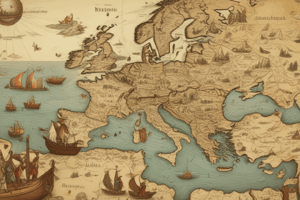Podcast
Questions and Answers
What devastating event marked the Late Middle Ages in Europe?
What devastating event marked the Late Middle Ages in Europe?
- The Black Death (correct)
- The Hundred Years' War
- The birth of the Renaissance
- The Peasants' Revolt
Which institution played an essential role in shaping medieval culture during the Middle Ages?
Which institution played an essential role in shaping medieval culture during the Middle Ages?
- Merchant Guilds
- Noble Families
- Monarchy
- The Catholic Church (correct)
Who were considered the elite warriors of the Middle Ages?
Who were considered the elite warriors of the Middle Ages?
- Scholars
- Knights (correct)
- Merchants
- Peasants
What characterized medieval art during the Middle Ages?
What characterized medieval art during the Middle Ages?
Which event transformed Europe during the Late Middle Ages despite social and economic challenges?
Which event transformed Europe during the Late Middle Ages despite social and economic challenges?
What type of works were commonly produced by artists in medieval Europe?
What type of works were commonly produced by artists in medieval Europe?
Which period of the Middle Ages is known for the rise of feudalism?
Which period of the Middle Ages is known for the rise of feudalism?
During the Early Middle Ages, which kingdom united much of Western Europe under Charlemagne?
During the Early Middle Ages, which kingdom united much of Western Europe under Charlemagne?
Which event sponsored by the Catholic Church took place during the High Middle Ages?
Which event sponsored by the Catholic Church took place during the High Middle Ages?
Which tribes overran the Roman Empire's western territories during the Early Middle Ages?
Which tribes overran the Roman Empire's western territories during the Early Middle Ages?
Which development in the High Middle Ages led to a more stable and organized society?
Which development in the High Middle Ages led to a more stable and organized society?
What contributed to the preservation of knowledge and development of Latin literacy during the Early Middle Ages?
What contributed to the preservation of knowledge and development of Latin literacy during the Early Middle Ages?
Flashcards are hidden until you start studying
Study Notes
Medieval History: A Journey through Europe's Middle Ages
From the fall of the Roman Empire in the 5th century to the Renaissance in the 14th century, the Middle Ages, or the Medieval period, was a time of profound change and complexity in Europe's history. This era, commonly divided into three sub-periods—Early, High, and Late Middle Ages—offers a treasure trove of fascinating events, people, and developments that continue to captivate historians and educate us today.
Early Middle Ages (5th–10th centuries)
During this period, Europe was plagued by invasions, as Germanic tribes such as the Franks, Visigoths, and Anglo-Saxons overran the Roman Empire's western territories. Despite these upheavals, new kingdoms and cultures emerged, most notably the Carolingian Empire, which united much of Western Europe under the rule of Charlemagne. The rise of monasteries and churches also contributed to the preservation of knowledge and the development of Latin literacy.
High Middle Ages (11th–13th centuries)
The High Middle Ages witnessed several significant developments. The rise of feudalism, which united landowners, soldiers, and farmers, led to a more stable and organized society. The Catholic Church also exerted a strong influence on medieval society, sponsoring the Crusades and encouraging pilgrimages to holy sites. During this time, cities also began to flourish, and new trade routes were established, which facilitated cultural and economic exchanges.
Late Middle Ages (14th–15th centuries)
The Late Middle Ages, or the Late Middle Period, was marked by the Black Death, a devastating plague that killed millions of people across Europe. The plague was followed by a period of social and economic upheaval, including the Peasants' Revolt in England and the Hundred Years' War between England and France. Despite these challenges, the Late Middle Ages also saw the birth of the Renaissance, a cultural and intellectual movement that would transform Europe.
The Church and Medieval Society
The Catholic Church's influence on medieval society cannot be overstated. Throughout the Middle Ages, the Church was one of the most powerful and well-organized institutions in Europe, with vast land holdings and a well-trained clergy. The Church played an essential role in shaping medieval culture, including the arts, education, and social norms.
Medieval Warfare
Military and martial arts flourished during the Middle Ages, and new weapons and tactics emerged. Knights, who were the elite warriors of the time, played a significant role in military campaigns throughout Europe. However, warfare was not confined to large-scale battles; feuds and conflicts were also common among the nobility.
Medieval Culture and Art
Medieval culture was diverse and rich, with a focus on religion, history, and chivalry. Artists produced a variety of works, including illuminated manuscripts, sculptures, and architecture. Medieval art was characterized by a strong sense of symbolism, and many works were created for religious and educational purposes.
Conclusion
Medieval history is a complex and fascinating period that offers valuable insights into the development of European society and culture. From the fall of the Roman Empire to the rise of the Renaissance, the Middle Ages were a time of profound change and transformation. By exploring the various aspects of medieval history, we can better understand the world we live in today and appreciate the legacy of this remarkable period.
Studying That Suits You
Use AI to generate personalized quizzes and flashcards to suit your learning preferences.




